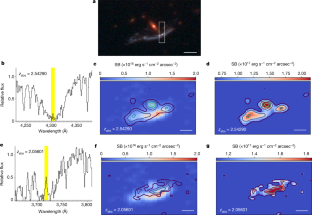2022-05-18 ノースカロライナ州立大学(NCState)
・強力な望遠鏡と自然界の力を借りた新しいユニークな装置によって、研究者は若い宇宙の中心にある銀河の苗床を覗き見ることができるようになりました。
・天体物理学者はクエーサー(光を発する超巨大ブラックホール)をDLA雲を検出するための「バックライト」として使用しています。この方法では、DLAの位置を正確に特定することはできますが、クエーサーからの光は巨大な雲を貫く小さな串のように作用するだけで、その大きさや質量を測定する努力の妨げになっています。
・ボルドロイとハワイ州カムエラにあるW.M.ケック天文台のジョン・オメーラ主任研究員は、重力レンズ銀河と積分視野分光法を用いて、ビッグバンから間もない約110億年前にできた二つのDLA(とその中のホスト銀河)を観測し、この問題を解決する方法を発見した。
<関連情報>
- https://news.ncsu.edu/2022/05/galaxy-a-cosmic-telescope-to-study-young-universe/
- https://www.nature.com/articles/s41586-022-04616-1
星形成の原動力となる減衰ライマンα系におけるH Iの解像力 Resolving the H I in damped Lyman α systems that power star formation
Rongmon Bordoloi,John M. O’Meara,Keren Sharon,Jane R. Rigby,Jeff Cooke,Ahmed Shaban,Mateusz Matuszewski,Luca Rizzi,Greg Doppmann,D. Christopher Martin,Anna M. Moore,Patrick Morrissey & James D. Neill
Nature Published:18 May 2022
DOI:https://doi.org/10.1038/s41586-022-04616-1

Abstract
Reservoirs of dense atomic gas (primarily hydrogen) contain approximately 90 per cent of the neutral gas at a redshift of 3, and contribute to between 2 and 3 per cent of the total baryons in the Universe1,2,3,4. These ‘damped Lyman α systems’—so called because they absorb Lyman α photons within and from background sources—have been studied for decades, but only through absorption lines present in the spectra of background quasars and γ-ray bursts5,6,7,8,9,10. Such pencil beams do not constrain the physical extent of the systems. Here we report integral-field spectroscopy of a bright, gravitationally lensed galaxy at a redshift of 2.7 with two foreground damped Lyman α systems. These systems are greater than 238 kiloparsecs squared in extent, with column densities of neutral hydrogen varying by more than an order of magnitude on scales of less than 3 kiloparsecs. The mean column densities are between 1020.46 and 1020.84 centimetres squared and the total masses are greater than 5.5 × 108–1.4 × 109 times the mass of the Sun, showing that they contain the necessary fuel for the next generation of star formation, consistent with relatively massive, low-luminosity primeval galaxies at redshifts greater than 2.



